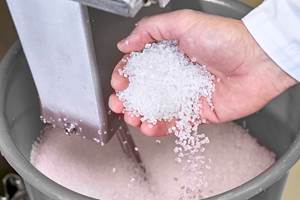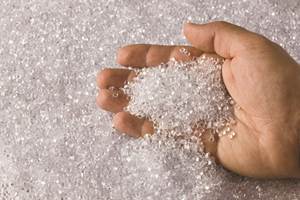Coextrusion Adds Shine to PP For Thermoforming Large Parts
New coextruded resin combinations are making polypropylene a contender for large thermoformed parts in outdoor uses from pleasure boats to automotive exterior trim.
New coextruded resin combinations are making polypropylene a contender for large thermoformed parts in outdoor uses from pleasure boats to automotive exterior trim. A major developmental program at Montell Polyolefins, Wilmington, Del., is aimed at giving PP-based sheet the right combinations of processability, glossy appearance, and ruggedness to compete cost-effectively with weatherable styrenics, acrylic, and even fiberglass/polyester thermoset composites.
Montell's strategy is to use multi-layered combinations of different resins in its PP-based portfolio
Montell believes that "integrated systems" are necessary because no one material can provide the specific combinations of properties
At this point, the main focus is on thermoforming coextruded sheet. (For development purposes, Montell has installed a Battenfeld Gloucester three-extruder sheet line capable of making two- and three-layer sheet up to 48 in. wide.) However, this concept can be applied to other multi-layer processing techniques like coinjection molding, coextrusion blow molding, and even low-pressure injection molding of PP behind an insert of preformed sheet/foam laminate.
High-melt-strength sheet
Virtually all Montell's thermoformable structures are based on the company's family of high-melt-strength PP, the Pro-fax HMS series. The goal is to combine a core of HMS PP with a cap layer of another Montell resin chosen for gloss or other functional properties.
In thermoforming, PP has been limited mostly to solid-phase forming of small packaging items. Large-part thermoforming has been traditionally constrained by the inherently low melt strength of PP and its loss of gloss during forming. With the introduction of Montell's HMS family of PP homopolymers and copolymers in the early 1990s, large parts could be thermoformed in the melt phase. Electron-beam radiation is used to induce long-chain branching in PP, which enhances melt strength. "HMS PP was developed for its resistance to sag in the molten phase," explains senior technology manager Alam Shah. HMS is also used to make foams and extrusion coatings.
"While the Pro-fax HMS family essentially took care of PP's melt-strength limitations, it did not address the gloss required in most types of large thermoformed parts, such as auto exterior panels. The integrated-systems approach brings these together," says Jim Keeler, advanced program manager at Montell's Automotive Business Group.
Three products in the HMS family are said to be particularly suited to large-part thermoforming and blow molding. Pro-fax PF716 homopolymer (1.8 MFR) has a tensile yield strength of 5400 psi, flex modulus of 240,000 psi, HDT of 247 F at 66 psi, and notched Izod impact of 1.3 ft-lb/in. Pro-fax SD613 heterophasic copolymer (0.45 MFR ) has a tensile strength of 4400 psi, flex modulus of 190,000 psi, HDT of 221 F, and "no-break" notched Izod. The third product, Pro-fax PF623 homopolymer (15 MFR), is a melt-strength enhancing additive for extrusion.
Candidates for a cap layer can include Hivalloy W (PP/PMMA) or one of several "soft-touch" TPOs or PP copolymers. Montell says it has patent-pending materials in development, but no details were disclosed.
Technology becomes reality
Montell has several active programs with major sheet producers and thermoformers. "We are now running PP-based materials 0.1 to 0.3 in. thick on conventional heavy-gauge thermoforming machines," says Formaro. Montell has produced large thermoformed parts with 60° gloss values over 80% and ductile impact behavior at sub-zero temperatures. Flexural modulus can be tailored over a wide range (see table). At the higher stiffnesses, thermoformed PP reportedly can compete with FRP composites in car and truck parts, marine uses, and spas.
The first commercial large-part thermoformed application is the deck of new power boats that can be rented at Walt Disney World in Orlando, Fla. Coming soon are large body panels for cars and all-terrain vehicles.
The deck of the 9-ft Disney World boat is thermoformed from a coextruded sheet of which 80% is a core of HMS PP and 20% is a cap layer of a highly crystalline specialty grade of PP, reports Shah. Compared with the coextruded ABS/ASA sheet formerly used, it is said to have at least twice the impact resistance and much higher chemical resistance. After forming, gloss level (60°) of the PP sheet is over 80%, equal to that of ASA-capped ABS. Due to its excellent formability, HMS PP sheet of 0.275 in. reportedly yields greater part thickness in deep-draw areas than does ABS/ASA sheet of 0.318 in. Downgauging translates into a significant cost advantage over the incumbent material, says Shah.
Related Content
Delivering Increased Benefits to Greenhouse Films
Baystar's Borstar technology is helping customers deliver better, more reliable production methods to greenhouse agriculture.
Read MorePrices for PE, PS, PVC, PET Trending Flat; PP to Drop
Despite price increase nominations going into second quarter, it appeared there was potential for generally flat pricing with the exception of a major downward correction for PP.
Read MorePrices Up for All Volume Resins
First quarter was ending up with upward pricing, primarily due to higher feedstock costs and not supply/demand fundamentals.
Read MoreFundamentals of Polyethylene – Part 3: Field Failures
Polyethylene parts can fail when an inappropriate density is selected. Let’s look at some examples and examine what happened and why.
Read MoreRead Next
See Recyclers Close the Loop on Trade Show Production Scrap at NPE2024
A collaboration between show organizer PLASTICS, recycler CPR and size reduction experts WEIMA and Conair recovered and recycled all production scrap at NPE2024.
Read MoreMaking the Circular Economy a Reality
Driven by brand owner demands and new worldwide legislation, the entire supply chain is working toward the shift to circularity, with some evidence the circular economy has already begun.
Read MoreBeyond Prototypes: 8 Ways the Plastics Industry Is Using 3D Printing
Plastics processors are finding applications for 3D printing around the plant and across the supply chain. Here are 8 examples to look for at NPE2024.
Read More












